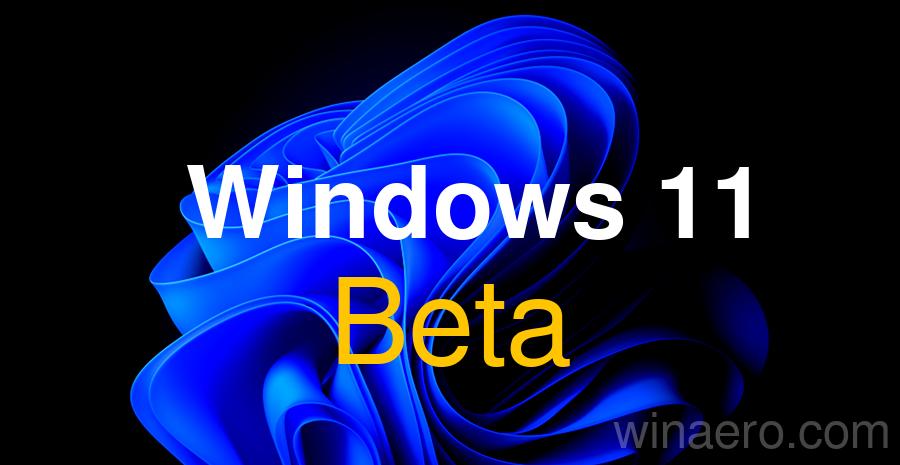Along with the major Dev channel update, Microsoft is releasing Windows 11 Build 22631.1972/22621.1972 to Insiders in the Beta channel. Build 22631 allows testing the Windows App SDK-based File Explorer. Both builds also come with a good number of various fixes and general improvements.
What's new in Windows 11 Build 22631.1972
Windows 11 Insiders on the Beta channel using builds 22631 will now be testing the Windows App SDK-based File Explorer Preview. At the same time, the capabilities of Explorer have not changed, so for now we are only talking about switching from WinUI 2 to WinUI 3.
Fixes in build 22631.1972
The "Hide date and time in system tray" option in Settings should no longer be inverted (on = off, off = on).
Fixes in both builds 22631.1972/22621.1972
- New! Updated several fonts for Simplified Chinese and Microsoft Pinyin IME to support GB18030-2022. This update enables the input and display of compliance level 1 or 2 characters using the Microsoft add-ons Yahei, Simsun, and Dengxian. The Simsun Ext-B font now supports the E and F Unicode extensions to meet level 3 requirements.
- New! Now you can authenticate in the Microsoft cloud. This function also satisfies Conditional Access checks if they are needed.
- New! Now when you share a local file in File Explorer, you can send it not only to contacts from Outlook, but also to yourself by email. In addition, improvements have been made to the process of downloading contacts from Outlook. This feature is not available for files stored in OneDrive because OneDrive has its own sharing mechanism.
- New! Notifications for Microsoft accounts in the Start menu will now appear for more users. A Microsoft account is what ties Windows to Microsoft apps, backs up all your data, helps you manage subscriptions, and adds extra security measures so your account is never lost. With this feature, Microsoft intends to send important account-related notifications. Notifications can be turned off in Settings -> Personalization -> Start.
- New! This update brings with it many new features and improvements to Microsoft Defender for Endpoint. Details can be found on the official website .
- Fixed an issue that caused the TextInputHost.exe application to quit unexpectedly.
- Fixed an issue that caused the permissions on the HKCU\Software\Microsoft\Windows\CurrentVersion\Explorer\User Shell key to be set incorrectly, causing Start Menu, Search, and Azure AD authentication to fail.
- Fixed an issue where devices with Network Protector for BitLocker would not wake up from sleep.
- Fixed an issue resulting in applications using the IDBObjectStore not working in Microsoft Edge and IE browsers.
- Fixed an issue that caused a scheduled monthly task to run with a delay during daylight savings time.
- Fixed an issue that caused Narrator to announce the wrong state when deselecting a button.
- Fixed an issue that prevented users from opening an elevated Windows Terminal when using an administrator account if they were not previously signed in with that account.
- Fixed an issue that caused File Explorer (explorer.exe) to quit unexpectedly.
- Fixed an issue resulting in Narrator not saving scan mode when switching between browsers.
- Fixed an issue that caused apps that scan barcodes to quit unexpectedly.
- Fixed an issue resulting in devices with less than 3.5 GB of RAM not receiving push notifications from Microsoft Intune.
- Fixed an issue where Teams didn't notify you of missed calls or messages.
- Fixed an issue that caused File Explorer windows to pop up unexpectedly in the foreground.
- Fixed an issue that prevented Active Directory from processing events with ID 1644 longer than 64 KB. LDAP queries in these events are now truncated to the default 20,000 characters or to a custom value set by the "DEFAULT_DB_EXPENSIVE_SEARCH_FILTER_MAX_LOGGING_LENGTH_IN_CHARS" registry key.
- Fixed an issue that prevented Azure Virtual Desktop and Windows 365 users from choosing the correct location for a remote desktop session on a virtual machine or cloud PC.
- This update improves the stability of Windows.
- Fixed an issue that caused some headphones to stop playing music.
- Fixed an issue where minor updates to .msi files were not installed when using EnterpriseDesktopAppManagement (CSP) to distribute MSI files.
- Fixed an issue where the tib.sys driver would not load when HyperVisor-protected Code Integrity (HVCI) was enabled.
- Fixed an issue resulting in the Touch Keyboard not opening after the device was locked.
- Fixed an issue that caused msftconnecttext.net to receive excessive HTTP traffic.
- Fixed an issue that could cause the PC to generate Timeout Detection and Recovery (TDR) errors while playing a game.
- Fixed an issue where users with the "Require smart card for interactive login" option enabled could not authenticate to Remote Desktop Services servers when RC4 is disabled. Error message: "An authentication error has occurred. The requested encryption type is not supported by the KDC."
- Fixed an issue where right-clicking a local file in the Recommended section of the Start menu did not produce the expected result.
- Improved stability of the Desktop Window Manager (DWM).
- Fixed an issue where all registry settings in policy paths could be deleted if the user policy local temporary file was not renamed correctly during Group Policy processing.
- Fixed an issue that caused the print spooler service to quit unexpectedly when printing from a specific workspace.
- Fixed an issue that could cause videos to flicker in some apps.
- Fixed an issue that could cause File Explorer to hang indefinitely when trying to view valid file permissions.
Support us
Winaero greatly relies on your support. You can help the site keep bringing you interesting and useful content and software by using these options:
